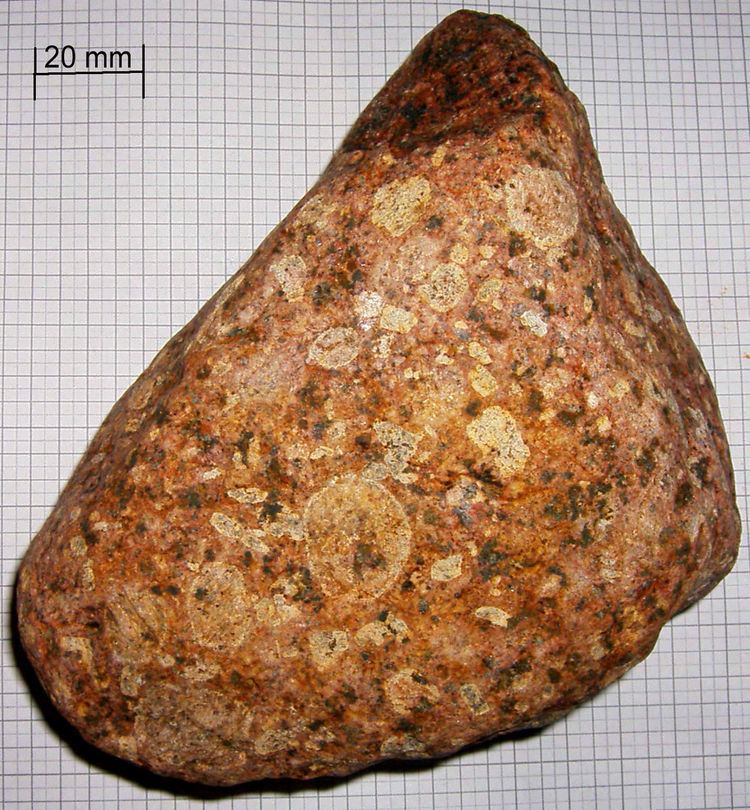 | ||
Rapakivi granite is a hornblende-biotite granite containing large rounded crystals of orthoclase each with a rim of oligoclase (a variety of plagioclase). The name has come to be used most frequently as a textural term where it implies plagioclase rims around orthoclase in plutonic rocks. Rapakivi is Finnish for "crumbly rock", because the different heat expansion coefficients of the component minerals make exposed rapakivi crumbly.
Contents
Rapakivi was first described by Finnish petrologist Jakob Sederholm in 1891. Since then, southern Finland's rapakivi granite intrusions have been the type locality of this variety of granite.
Occurrence
Rapakivi is a fairly uncommon type of granite, but has been described from localities in North and South America, parts of the Baltic Shield, southern Greenland, Uruguay, southern Africa, India and China. Most of these examples are found within Proterozoic metamorphic belts, although both Archaean and Phanerozoic examples are known.
Best known occurrence range is from Ukraine, through Finland and Scandinavia, southern Greenland to the Labrador peninsula and on through the North American continent to California.
Formation
Rapakivi granites have formation ages from Archean to recent and are usually attributed to anorogenic tectonic settings. They have formed in shallow (a few km deep) sills of up to 10 km thickness.
Rapakivi granites are often found associated with intrusions of anorthosite, norite, charnockite and mangerite. It has been suggested that the entire suite results from the fractional crystallization of a single parental magma.
Geochemistry
Rapakivi is enriched in K, Rb, Pb, Nb, Ta, Zr, Hf, Zn, Ga, Sn, Th, U, F and rare earth elements, and poor in Ca, Mg, Al, P and Sr. Fe/Mg, K/Na and Rb/Sr ratios are high. SiO2 content is 70.5%, which makes rapakivi an acidic granite.
Rapakivi is high in fluoride, ranging 0.04–1.53%, compared to other similar rocks at around 0.35%. Consequently, groundwater in rapakivi zones is high in fluoride (1–2 mg/l), making the water naturally fluoridated. Some water companies actually have to remove fluoride from the water.
The uranium content of rapakivi is fairly high, up to 24 ppm. Thus, in rapakivi zones, the hazard from radon, a decay product of uranium, is elevated. Some indoor spaces surpass the 400 Bq/m3 safety limit.
Petrography
Vorma (1976) states that rapakivi granites can be defined as:
A more recent definition by Haapala & Rämö states:
Rapakivi granites are type-A granites, where at least in larger associated batholites have granites with rapakivi structures.
Use as a building material
Rapakivi is the material used in Åland's Middle Age stone churches. In 1770 a rapakivi granite monolith boulder, the "Thunder Stone", was used as the pedestal for the Bronze Horseman statue in Saint Petersburg, Russia. Weighing 1,250 tonnes, this boulder is claimed to be the largest stone ever moved by humans. Modern building uses of rapakivi granites are in polished slabs used for covering buildings, floors, counter tops or pavements. As a building material, rapakivi granite is also known as "Baltic Brown".
